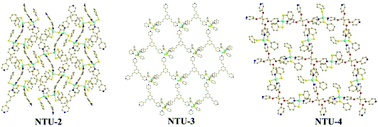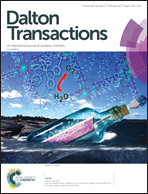Multitopic ligand directed assembly of low-dimensional metal-chalcogenide organic frameworks†
Abstract
Despite tremendous progress in metal–organic frameworks, only limited success has been achieved with metal-chalcogenide organic frameworks. Metal-chalcogenide organic frameworks are desirable because they offer a promising route towards tunable semiconducting porous frameworks. Here, four novel semiconducting chalcogenide-organic hybrid compounds have been synthesized through a solvothermal method. Multitopic organic molecules, i.e., 1,2-di-(4-pyridyl)ethylene (L1), 1,3,5-tris(4-pyridyl-trans-ethenyl)benzene (L2) and tetrakis(4-pyridyloxymethylene)methane (L3), have been used as linkers to assemble Zn(SAr)2 or Zn2(SAr)4 units to generate different patterns of spatial organizations. Single-crystal structural analyses indicate that compounds NTU-2, NTU-3 and NTU-4 possess two-dimensional layer structures, while compound NTU-1 adopts a one-dimensional coordination framework (NTU-n, where n is the number related to a specific structure). The diffuse-reflectance spectra demonstrate that these four compounds possess indirect bandgaps and their tunable bandgaps are correlated with their compositions and crystal structures.



 Please wait while we load your content...
Please wait while we load your content...